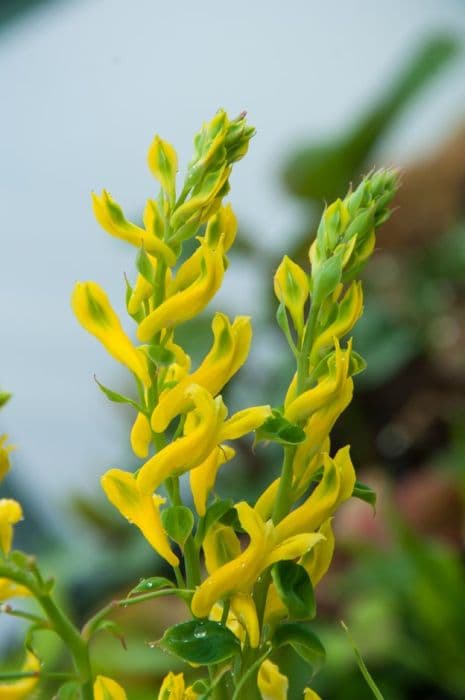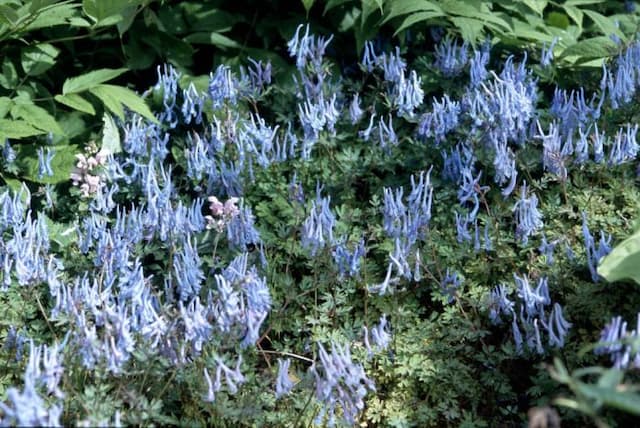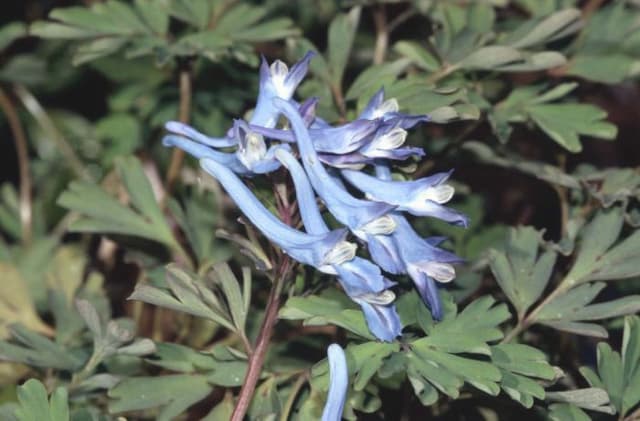Matilija Poppy Romneya coulteri

ABOUT
The plant commonly known as Matilija poppy has a distinctive and striking appearance, characterized by its large, showy flowers that are reminiscent of fried eggs. These blossoms are composed of a central cluster of yellow stamens which are surrounded by crepe-paper like petals, pure white in color, contributing to its fried egg analogy. The flowers are quite large and tend to be the highlight of the plant, drawing the attention of gardeners and pollinators alike. Matilija poppy has a lush foliage that provides a contrasting backdrop to its bright flowers. The leaves are bluish-green with a ferny appearance, having a finely divided structure that gives them a delicate, feathery look. This serves to further accentuate the plant's blooms, making the white petals stand out even more. The stems of Matilija poppy are typically woody at the base and can spread out, creating a dense and shrubby appearance from afar. This dense growth habit adds to the plant’s wild and naturalistic appeal, making it a striking addition to gardens that aim for a more untamed or native look. Overall, the Matilija poppy is appreciated for its ornamental beauty provided by its unique flowers and attractive foliage, which together create a visually appealing plant popular in garden landscapes that favor bold, eye-catching specimens.
About this plant
 Names
NamesFamily
Papaveraceae
Synonyms
Matilija Poppy, California Tree Poppy, Coulter's Matilija Poppy, Fried Egg Flower, Cowboy's Fried Egg
Common names
Romneya trichocalyx, Romneya coulteri var. glabra, Romneya coulteri var. trichocalyx
 Toxicity
ToxicityTo humans
The plant commonly known as the Matilija poppy is not widely recognized as toxic to humans. There are no well-documented cases or reports of poisoning from the ingestion of the Matilija poppy. As with any plant, individual reactions can vary, and it is generally wise to avoid ingesting plants that are not commonly recognized as food, but there is no specific information suggesting that the Matilija poppy is poisonous to humans.
To pets
The plant commonly known as the Matilija poppy is not widely recognized as toxic to pets either. Like with humans, there are no well-documented cases or reports of pets being poisoned by the ingestion of parts of the Matilija poppy. However, individual pets may have varying sensitivities, and it is generally wise to prevent pets from ingesting ornamental plants. As with any non-food plant, monitoring pets around the Matilija poppy is advisable, but there is no specific information available that indicates this plant is toxic to pets.
 Characteristics
CharacteristicsLife cycle
Perennials
Foliage type
Deciduous
Color of leaves
Blue-green
Flower color
White
Height
6 feet (1.8 meters)
Spread
4 feet (1.2 meters)
Plant type
Shrub
Hardiness zones
7
Native area
California
Benefits
 General Benefits
General Benefits- Aesthetic Appeal: The Matilija poppy offers large, showy white flowers with a bright yellow center, making it a striking addition to any garden or landscape.
- Drought Tolerance: Once established, the Matilija poppy is very drought-tolerant, making it suitable for xeriscaping and water-wise gardens.
- Low Maintenance: It generally requires minimal care, thrive in poor soil, and do not need regular fertilization or pruning.
- Habitat for Wildlife: The flowers provide nectar for pollinators like bees and butterflies, while sheltering beneficial insects.
- Erosion Control: The Matilija poppy's extensive root system can help stabilize slopes and areas prone to erosion.
 Medical Properties
Medical PropertiesThis plant is not used for medical purposes.
 Air-purifying Qualities
Air-purifying QualitiesThis plant is not specifically known for air purifying qualities.
 Other Uses
Other Uses- The Coulter's Matilija poppy can be used as a firebreak plant due to its deep roots and resistance to fire in its native habitats, thus can be planted to help reduce fire risk.
- Due to its large and showy flowers, the plant is often used for ornamental purposes in landscaping to create a dramatic visual impact in large garden spaces.
- The stems and seed pods of the Coulter's Matilija poppy can be used in dried flower arrangements, adding a unique texture and appearance to the composition.
- The plant can be utilized in erosion control projects because its extensive root system helps stabilize loose soils on slopes and banks.
- The durable fibers from the plant have been traditionally used for making items like twine or rope in native and historical applications.
- Its nectar and pollen offer food resources for bees and butterflies, thus playing a role in supporting local pollinator populations.
- The plant's vigorous growth habit makes it suitable as a living screen for privacy or to block undesirable views when planted in a row or mass.
- The Coulter's Matilija poppy can be used as a natural dye, giving a range of colors from yellow to green depending on the mordant used.
- As an educational tool, this plant is ideal for teaching botany and ecology due to its distinct characteristics and role in native plant communities.
- The Coulter's Matilija poppy's bold silhouette and aesthetic form make it a subject for photographers and artists who seek to capture the essence of California's native flora.
Interesting Facts
 Feng Shui
Feng ShuiThe Matilija poppy is not used in Feng Shui practice.
 Zodiac Sign Compitability
Zodiac Sign CompitabilityThe Matilija poppy is not used in astrology practice.
 Plant Symbolism
Plant Symbolism- Beauty: The Romneya coulteri, commonly known as the Matilija poppy, is known for its striking and large white flowers, symbolizing exceptional beauty and the appreciation of it.
- Resilience: As a plant native to California, the Matilija poppy is adapted to survive in harsh conditions, making it a symbol of strength and the ability to overcome adversity.
- Rarity: Due to its specific growing requirements and difficulty to propagate, the Matilija poppy represents rarity and exclusiveness in the world of plants.
- Peace: The white color of its blooms is often associated with peace and tranquility, signifying a desire for serenity.
- Resistance: The Matilija poppy has a reputation for being hard to remove once established, symbolizing enduring presence and resistance to change.
 Water
WaterThe Romneya coulteri, commonly known as the Matilija poppy, prefers a watering routine that allows the soil to dry out between waterings. This plant is drought-tolerant and does not require frequent watering. In general, watering once every two weeks should be sufficient, but this can vary depending on climate and soil conditions. When watering, thoroughly soak the soil to a depth of several inches, using approximately 1 to 2 gallons of water per plant, depending on the size. During the hot summer months, you may need to water more frequently, but always check the soil moisture before adding water.
 Light
LightThe Matilija poppy thrives in full sunlight and should be planted in a spot where it will receive at least six to eight hours of direct sun each day. This plant is accustomed to the intense sunshine found in its native California habitats and does best in open areas without shade. Avoid planting it in shaded or partially shaded locations, as insufficient light can impede its growth and flowering.
 Temperature
TemperatureThe Matilija poppy can endure a broad range of temperatures, surviving minimum temperatures down to approximately 20 degrees Fahrenheit and tolerating the high temperatures of its native California climate. The ideal temperature range for cultivating this plant is between 60 to 85 degrees Fahrenheit, which promotes optimal growth and flowering. However, once established, the Matilija poppy is fairly adaptable and can cope with occasional temperature extremes.
 Pruning
PruningPruning the Matilija poppy should be done to remove dead or damaged stems and to shape the plant if desired. It is best to prune the plant during the late fall or early winter after the flowering season has ended. Prune sparingly, as Matilija poppies do not require heavy pruning and can be sensitive to over-pruning. Deadheading spent blooms can encourage further flowering and help maintain the plant's appearance.
 Cleaning
CleaningNot needed
 Soil
SoilMatilija poppy thrives best in well-draining soil with low fertility. A mix containing loamy soil, sand, and perlite can assist in drainage and mimic its native habitat conditions. The soil pH should ideally be neutral to slightly alkaline, around 6.0 to 7.5.
 Repotting
RepottingMatilija poppies are best not repotted often as they have a deep taproot system and do not like root disturbance. Repotting is generally unnecessary unless the plant has outgrown its container or the soil needs refreshing.
 Humidity & Misting
Humidity & MistingMatilija poppy prefers low to moderate humidity levels and is quite drought-tolerant. It is well-suited to the dry conditions typically found in its native California habitat.
 Suitable locations
Suitable locationsIndoor
Not ideal indoor; needs full sun, well-draining soil.
Outdoor
Plant in full sun, well-drained soil, space well.
Hardiness zone
7-10 USDA
 Life cycle
Life cycleThe life cycle of Romneya coulteri, commonly known as Matilija poppy or California tree poppy, begins with seed germination, which is enhanced by fire or scarification due to their hard seed coats. Once the seeds germinate, seedlings establish themselves and grow into large perennial subshrubs with a deep root system. The plant then enters a vegetative stage, developing gray-green foliage and stems that can reach up to 8 feet tall. During spring and summer, Romneya coulteri produces large, showy white flowers with a yellow center, which are pollinated by insects, leading to the formation of seed capsules. After pollination, the seeds mature and are dispersed by wind or gravity. Finally, the plant may go dormant in response to cold or drought, conserving energy to regrow from its roots in the following growing season.
 Propogation
PropogationPropogation time
Spring-Early Summer
The most popular method of propagation for Romneya coulteri, commonly known as the Matilija poppy or California tree poppy, is by root cuttings. Generally, the optimal time for taking root cuttings is late fall to early winter. To propagate by root cuttings, gardeners carefully excavate around the parent plant to expose its fleshy roots. A section of root about 2 to 4 inches (5 to 10 centimeters) in length is cut and then planted horizontally or vertically in a well-draining soil mix, ideally in a container. The cutting should be kept moist but not waterlogged, and in a cool but frost-free environment until it shows signs of growth, which typically occurs in the spring. Once new shoots begin to appear and a healthy root system is established, the young plants can be transplanted into the garden.









